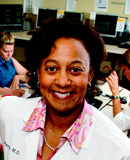 Shawna J. Perry, M.D., is talking about casinos. It seems an unlikely subject for the director of Patient Safety Systems Engineering, but Perry insists it’s relevant. “One of the biggest challenges for safety today is accepting that health care is just another form of work, not that different from other systems,” she says. “Take casinos, for example. They are 24-hour operations like health care. They’ve put a lot of money into studying the effects of sleep deprivation on attention span to optimize employee performance–something that directly impacts us as well.”
Shawna J. Perry, M.D., is talking about casinos. It seems an unlikely subject for the director of Patient Safety Systems Engineering, but Perry insists it’s relevant. “One of the biggest challenges for safety today is accepting that health care is just another form of work, not that different from other systems,” she says. “Take casinos, for example. They are 24-hour operations like health care. They’ve put a lot of money into studying the effects of sleep deprivation on attention span to optimize employee performance–something that directly impacts us as well.”
Perry came to the MCV Campus in the fall of 2008 from the University of Florida Health Sciences Center in Jacksonville, where she was director of the emergency department and did research on patient safety. Today she combines teaching, research and clinical care with oversight of the safety initiative. “Safety First, Every Day is a team effort,” she emphasizes. “We’re right now in Phase II of our journey to become one of the safest organizations in the nation.”
Although there are many factors that contribute to a safe environment, Perry is particularly interested in the pros and cons of new technology. There is no question sophisticated medical software has made tracking patient progress more reliable. However, Perry says clinicians now spend as much as 20 percent of their time entering data on a computer–time previously devoted to hands-on patient care.
She laughs as she describes her research that involves “patting down a resident” at day’s end and finding a pocket full of handwritten notes. “These are cognitive artifacts that support aspects of clinical work,” says Perry. “Studying notes like these allows us to follow someone’s train of thought and see more clearly what is not–but should be–supported by technology.”
In Perry’s view: “Safety is a dynamic, ongoing aspect of any system.”
Just ask the Las Vegas croupiers, now on a new routine of staggered sleep schedules.
By Susan T. Burtch, for the Dean’s Discovery Report.